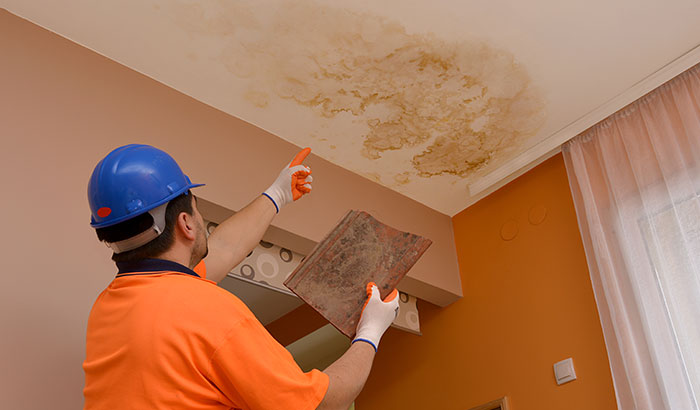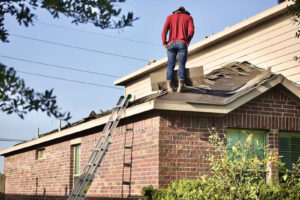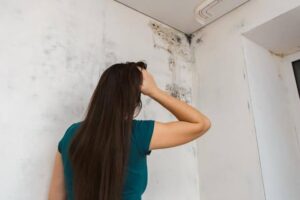Finding the source of a water leak in your home can be a challenging and frustrating task. Water leaks not only cause damage to your property, but they can also lead to expensive repairs if left unattended. Detecting and fixing water leaks as soon as possible is essential to prevent further damage.
In this article, we will tell you how to find a leak source and what steps to take if that leak source has led to water damage in your home.
First up, here are ten ways to find the source of a water leak in your home:
1 – Check for visible signs of water damage
The first step to finding the water leak source is to check for visible signs of water damage. Water damage can take many forms, including peeling paint, water stains, mold growth, and warped or sagging walls or ceilings. Look for water damage in areas where water is commonly used, such as bathrooms, kitchens, and laundry rooms. Also, check around your water heater and any pipes or fixtures that may have been recently installed or repaired.
If you find any visible signs of water damage, mark the area and investigate further. You may need to cut away drywall or remove ceiling tiles to inspect the area thoroughly.
2 – Monitor your water meter
Your water meter can be an invaluable tool for detecting water leaks. To use your water meter to find a leak, turn off all faucets and water-consuming appliances in your home, then note the meter reading. Wait for a few hours without using any water and recheck the meter. If the meter reading has changed, it indicates that water is still flowing somewhere in your home, and you likely have a leak.
To pinpoint the source of the leak, turn off the main water supply to your home and watch the meter. If the meter continues to spin, the leak is likely in the main water line. If the meter stops, the leak is likely in your home’s plumbing.
3 – Listen for running water
You likely have a water leak if you hear running water when no faucets or appliances are used. To find the source of the leak, turn off all water-using appliances and listen for the sound of running water. If the sound is coming from a particular area, investigate further. If you cannot pinpoint the leak’s location, turn off the main water supply and listen again. If the sound stops, the leak is likely in your home’s plumbing.
4 – Perform a dye test
A dye test is a simple way to detect a leak in your toilet. Add a few drops of food coloring or dye to the toilet tank to perform a dye test. Wait for a few minutes without flushing the toilet. If you see the dye in the toilet bowl, it indicates that water is leaking from the tank to the bowl, and you may need to replace the flapper or the entire toilet.
5 – Check your water heater
A leaking water heater can cause significant damage to your home. To check for a water heater leak, inspect the area around the tank for signs of moisture. If you find any wet spots or puddles, check the connections to the water supply and the temperature and pressure relief valve. If these connections are not the source of the leak, you may need to replace the tank or hire a professional plumber to repair the leak.
6 – Inspect your roof
A leaking roof can cause water damage in your home, even if the source of the leak is not directly above the affected area. To inspect your roof, climb onto the roof and look for damaged or missing shingles, cracked or damaged flashing, and damaged or rusted vent pipes. If you are not comfortable climbing onto your roof, hire a professional roofing contractor to perform the inspection.
7 – Use a thermal imaging camera
A thermal imaging camera can detect water leaks by measuring temperature differences in walls and ceilings. Water leaks can cause temperature changes in building materials, which can be detected with a thermal imaging camera.
To use a thermal imaging camera, turn off all HVAC systems and fans in your home, then scan the walls and ceilings with the camera. Look for areas that are cooler or warmer than the surrounding areas, which can indicate the presence of water.
Once you have identified a potential water leak using the thermal imaging camera, investigate further to confirm the source of the leak. Note that thermal imaging cameras can be expensive, so you may need to hire a professional inspector to use one.
8 – Use a moisture meter
A moisture meter is a tool that measures the moisture content of building materials. Using a moisture meter, you can detect water leaks that may not be visible to the naked eye. To use a moisture meter, place the device against the surface of the wall or ceiling and note the moisture reading. Moisture readings above 15% indicate the presence of water.
9 – Perform a smoke test
A smoke test is a way to detect leaks in your home’s plumbing system. A non-toxic smoke solution is pumped into your home’s plumbing system to perform a smoke test. The smoke will fill the pipes and come out of any leaks or cracks in the plumbing system. The smoke will not harm your home or its occupants.
To perform a smoke test, close all windows and doors in your home and turn off all fans and HVAC systems. Then, a plumber will insert a smoke generator into the plumbing system and pump smoke into the pipes. Walk through your home and look for areas where smoke is escaping, indicating the leak’s location.
10 – Hire a professional plumber or inspector
If you have tried all of the above methods and still cannot locate the source of the leak, it may be time to hire a professional plumber or inspector. A professional plumber or inspector will have specialized tools and equipment to detect leaks that may not be visible to the naked eye.
When hiring a professional, check their credentials and references to ensure they are qualified and reputable. Ask for a detailed estimate of the work to be performed and any associated costs. Hiring a professional can be expensive, so be sure to budget accordingly.
Detecting and fixing water leaks in your home is crucial to preventing further damage and expensive repairs. By using a combination of the above methods, you can locate the source of the leak and take appropriate action to fix the problem. Always exercise caution and safety when inspecting your home for water leaks, and consider hiring a professional if you are unsure or uncomfortable with the task.
What To Do if You Find a Water Leak in Your Home
Discovering a water leak in your home can be a stressful and frustrating experience. However, it’s important to take quick action to prevent further damage and minimize the cost of repairs.
Here are the steps to take if you have a water leak in your home:
- Shut off the main water supply: The first step in dealing with a water leak is to shut off the main water supply to your home. This will stop the flow of water and prevent further damage. The main water shut-off valve is usually located near the water meter or where the main water line enters your home. Make sure that everyone in your household knows where the main shut-off valve is located and how to turn it off.
- Turn off electricity and gas: If the water leak is near any electrical outlets, appliances, or gas lines, it’s important to turn off the electricity and gas supply to avoid potential hazards. If you need help doing this safely, it’s best to call a professional to assist you.
- Assess the extent of the damage: Once you have shut off the water supply, assess the extent of the damage. Look for any standing water, wet or damp areas, and any signs of mold or mildew. Take photos of the damage and contact your insurance company to file a claim. It’s important to document the damage for insurance purposes and help with future repairs.
- Dry out the affected area: Use towels, mops, or a wet/dry vacuum to remove as much water as possible. Drying out the affected area as quickly as possible is important to prevent mold and mildew growth. Open windows and doors to increase ventilation and use fans to circulate air. You can also use a dehumidifier to remove excess moisture from the air.
- Locate the source of the leak: Once the affected area is dry, locate the source of the leak. Check for any visible leaks from pipes, faucets, or appliances. If you can’t find the source of the leak, it may be behind a wall or ceiling, in which case you may need to call a plumber to locate and repair the leak.
- Repair the leak: Depending on the severity of the leak, you may be able to repair it yourself, or you may need to call a plumber. If the leak is caused by a broken or damaged pipe, it’s important to replace it to prevent future leaks.
- Clean and disinfect the area: Once the leak has been repaired, it’s important to clean and disinfect the affected area to prevent mold and mildew growth. Use a water and bleach solution or a commercial disinfectant to clean the area thoroughly. Be sure to wear gloves and protective gear when handling cleaning chemicals.
- Monitor for future leaks: After the repair has been completed, it’s important to monitor the area for future leaks. Check for signs of moisture, mold, or mildew regularly and fix any leaks promptly to prevent further damage. Consider having your plumbing system inspected by a professional to identify and address any potential issues before they become significant problems.
Dealing with a water leak can be a stressful experience, but by taking quick action and following these steps, you can prevent further damage and minimize the cost of repairs. It’s important to address water leaks promptly to avoid potential hazards and protect your home from future damage.
Leave it to Total Flood & Restoration!
If you have a water leak, chances are you’re looking at possible water damage in your home. If so, it’s time to contact Total Flood & Fire Restoration. Our trained professionals will resolve your home restoration or cleanup needs.
We are ready and willing to serve those in Utah, Davis, and Salt Lake City counties and are available 24/7. Call us @ (385) 442-9804, and let’s get started.








